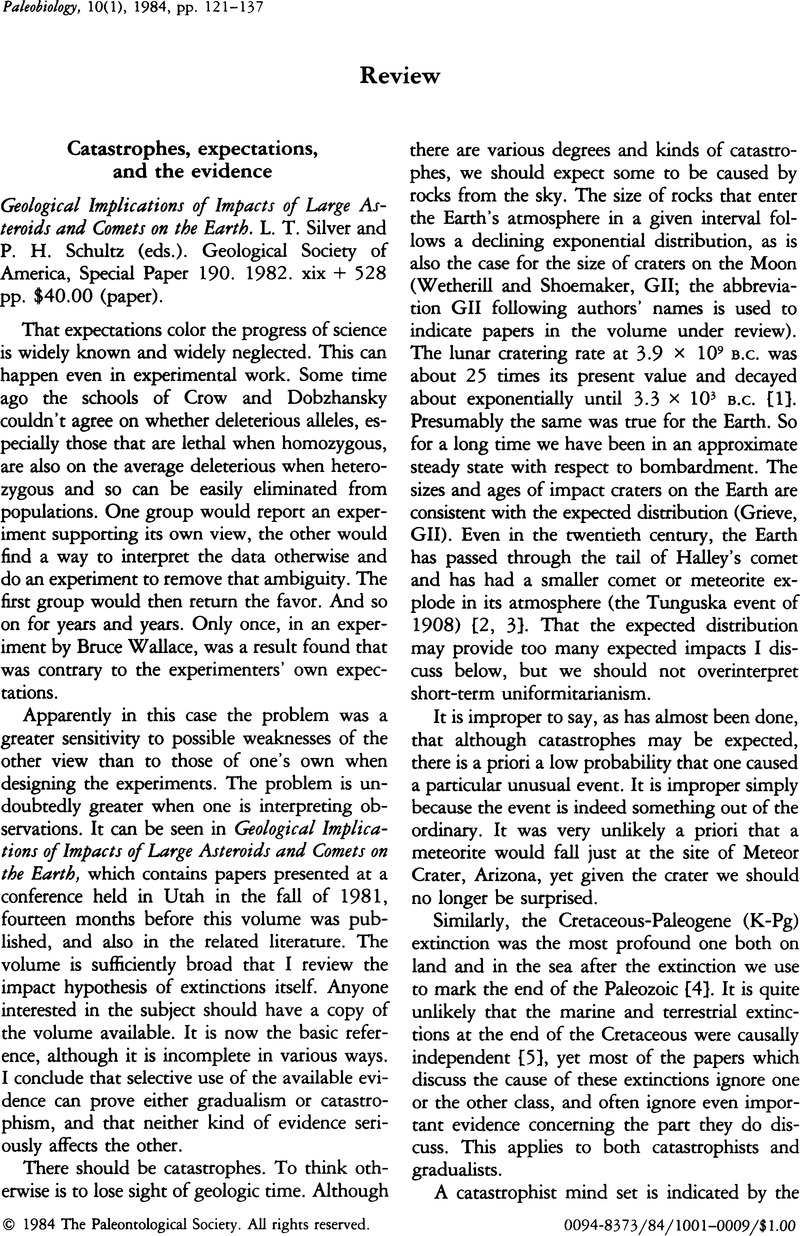Crossref Citations
This article has been cited by the following publications. This list is generated based on data provided by Crossref.
VAN VALEN, LEIGH M.
1984.
The case against impact extinctions.
Nature,
Vol. 311,
Issue. 5981,
p.
17.
Officer, Charles B.
and
Drake, Charles L.
1985.
Terminal Cretaceous Environmental Events.
Science,
Vol. 227,
Issue. 4691,
p.
1161.
Smit, J.
and
Romein, A.J.T.
1985.
A sequence of events across the Cretaceous-Tertiary boundary.
Earth and Planetary Science Letters,
Vol. 74,
Issue. 2-3,
p.
155.
McLean, Dewey M.
1985.
Evolutionary Biology.
p.
287.
O'Keefe, John A.
1985.
The terminal Cretaceous event: Circumterrestrial rings of tektite glass particles?.
Cretaceous Research,
Vol. 6,
Issue. 3,
p.
261.
Benton, Michael J.
1985.
Mass extinction among non-marine tetrapods.
Nature,
Vol. 316,
Issue. 6031,
p.
811.
Schmitz, Birger
1985.
Metal precipitation in the Cretaceous-Tertiary boundary clay at Stevns Klint, Denmark.
Geochimica et Cosmochimica Acta,
Vol. 49,
Issue. 11,
p.
2361.
Benton, Michael J.
1986.
The evolutionary significance of mass extinctions.
Trends in Ecology & Evolution,
Vol. 1,
Issue. 5,
p.
127.
Carpenter, Kenneth
and
Breithaupt, Brent
1986.
Latest Cretaceous occurrence of nodosaurid ankylosaurs (Dinosauria, Ornithischia) in Western North America and the gradual extinction of the dinosaurs.
Journal of Vertebrate Paleontology,
Vol. 6,
Issue. 3,
p.
251.
Officer, Charles B.
Hallam, Anthony
Drake, Charles L.
and
Devine, Joseph D.
1987.
Late Cretaceous and paroxysmal Cretaceous/Tertiary extinctions.
Nature,
Vol. 326,
Issue. 6109,
p.
143.
McGhee, George R.
1988.
The Late Devonian extinction event: evidence for abrupt ecosystem collapse.
Paleobiology,
Vol. 14,
Issue. 3,
p.
250.
Degens, Egon T.
1989.
Perspectives on Biogeochemistry.
p.
342.
Degens, Egon T.
1989.
Perspectives on Biogeochemistry.
p.
284.
Degens, Egon T.
1989.
Perspectives on Biogeochemistry.
p.
238.
Tredoux, M.
De Wit, M. J.
Hart, R. J.
Lindsay, N. M.
Verhagen, B.
and
Sellschop, J. P. F.
1989.
Chemostratigraphy across the Cretaceous-Tertiary Boundary and a Critical Assessment of the Iridium Anomaly.
The Journal of Geology,
Vol. 97,
Issue. 5,
p.
585.
Futuyma, Douglas J.
1990.
Evolutionsbiologie.
p.
391.
Whatley, Robin
1990.
Ostracoda and Global Events.
p.
3.
Stott, D.F.
Caldwell, W.G.E.
Cant, D.J.
Christopher, J.E.
Dixon, J.
Koster, E.H.
McNeil, D.H.
and
Simpson, F.
1993.
Sedimentary Cover of the Craton in Canada.
p.
358.
Matsuno, Koichiro
1994.
Evolution in the eyes of the participants and consumer‐regulated dynamics.
World Futures,
Vol. 42,
Issue. 3-4,
p.
251.
Chai, C. F.
Kong, P.
Mao, X. Y.
and
Ma, S. L.
1995.
Molecular activation analysis for iridium.
Journal of Radioanalytical and Nuclear Chemistry Articles,
Vol. 192,
Issue. 1,
p.
101.



